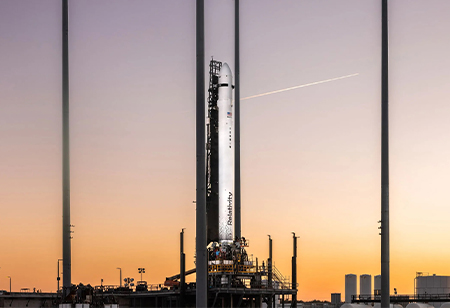
The World's First 3D-Printed Rocket Is Here


The development of 3D printing has aided both established designers and aspiring wardrobe designers. Individuals who once lacked the means of expression despite having extraordinary brain capacity for sculpture are now discovering new ways to do it. The opportunity to choose from a variety of techniques and materials allows designers to test out their concepts more frequently and quickly. Not only the designers but also the clients and art consumers have profited from the significant reduction in the time required for the idea generation and implementation processes.
The first 3D-printed rocket in the world is set to launch from Florida and is advertised as being less expensive to construct and fly. Relativity Space, a California-based aerospace business, had planned to launch the Terran 1 rocket at Cape Canaveral, but last-minute propellant temperature difficulties forced a postponement.
First Flight
Eight minutes after liftoff, Terran 1 is scheduled to enter low Earth orbit on a mission to collect data and show that a 3D-printed rocket can weather the rigors of launch and space travel. According to Relativity, if the rocket is successful in reaching low Earth orbit, it will be the first privately sponsored methane-fueled spacecraft to do so. The Terran 1 rocket will eventually be able to launch up to 2,755 pounds (1,250 kilograms) into low Earth orbit, but it is not carrying a payload on its initial flight. The rocket has a 7.5-foot diameter and a height of 110 feet (33.5 meters) (2.2 meters).
Printed with Metal Alloys
The engines are 3D printed with metal alloys, which account for 85 percent of its bulk. The Long Beach-based company claims it is the largest 3D-printed object ever and was created using the largest 3D metal printers in the world. The aim of Relativity is to create a rocket that is 95 percent 3D printed. According to Relativity, the Terran 1's Aeon engines run on liquid oxygen and liquid natural gas, the propellants of the future that could one day power a trip to Mars. The Starship rocket from SpaceX and United Launch Alliance are both developing Vulcan rockets. In its first stage, Terran 1 has nine 3D-printed Aeon 1 engines and one 3D-printed Aeon Vacuum engine.
Built Terran 1 Rocket in 60 days
Moreover, Relativity is developing the Terran R, a more powerful rocket that can launch a payload weighing up to 44,000 pounds (20,000 kg) into low-Earth orbit. The first Terran R, which is intended to be completely reusable, will launch from Cape Canaveral early next year. Relativity Space expects that its 3D-printed rockets will shorten the time that satellite operators must wait to board an Arianespace or SpaceX rocket. Because of its great cost effectiveness, radical flexibility, and customizability, 3D printing has the potential to democratize quickly. According to Relativity, its 3D-printed rockets can be assembled from raw materials in just 60 days and require 100 times fewer parts than conventional rockets. Tim Ellis, the CEO of Relativity and one of the business's co-founders, claims that the company has already inked commercial launch contracts worth $1.65 billion, most of which are for the Terran R. With the severe launch deficit in this payload class over the ensuing decade, medium-heavy lift represents the market opportunity with the most potential.
Applications of 3D Printing by Other Industries
Fast prototyping is extremely important before actual product manufacturing and implementation in the automotive sector. It should be common knowledge by now that 3D printing and rapid prototyping frequently work together. And the automobile business embraced 3D technology just as enthusiastically as the aerospace sector did. The new technology was incorporated while working alongside research teams to test and use 3D items in real applications. One of the industries most benefited from 3D printing and will continue to do so is the automotive industry. Some of the pioneers in the auto industry include Ford, Mercedes, Honda, Lamborghini, Porsche, and General Motors.
The medical industry was a pioneer in 3D printing. Medical experts have been using this technology since the early 1990s, making it one of the first industries to see the promise of 3D printing. Researchers had already implanted a 3D-printed organ in a human body by the late 1990s and early 2000s. Researchers from the Wake Forest Institute for Regenerative Medicine, 3D-printed artificial bladder components, say that the human body was then implanted with the freshly created tissue. The benefits of 3D printing for the medical industry have only increased with time. One-off examples include the usage of individualized prostheses, 3D-printed dental fixtures, and hearing aids that are created and tailored to the demands of the users. It won't be long before each hospital has a high-tech 3D printer that can quickly and easily produce bespoke organs like bones, skin, and tissues as needed. Although a lot will depend on the studies, it doesn't seem like it will be long before it becomes the standard.
The jewelry industry has always been intricate and labor-intensive. Each of the several processes involved in it requires extremely specific knowledge and expertise. The industry is very old, and its earliest beginnings predate many of the other industries on this list.
The 3D printing business might be considered a disruptive technology, specifically for jewelry. The jewelry business has been impacted by 3D printing, which is now streamlining the old procedures in order to maximize and utilize the technology's potential. Technology has made it possible to make huge quantities of ready-to-cast jewelry and has made it simpler to quickly develop jewelry designs that precisely suit clients.